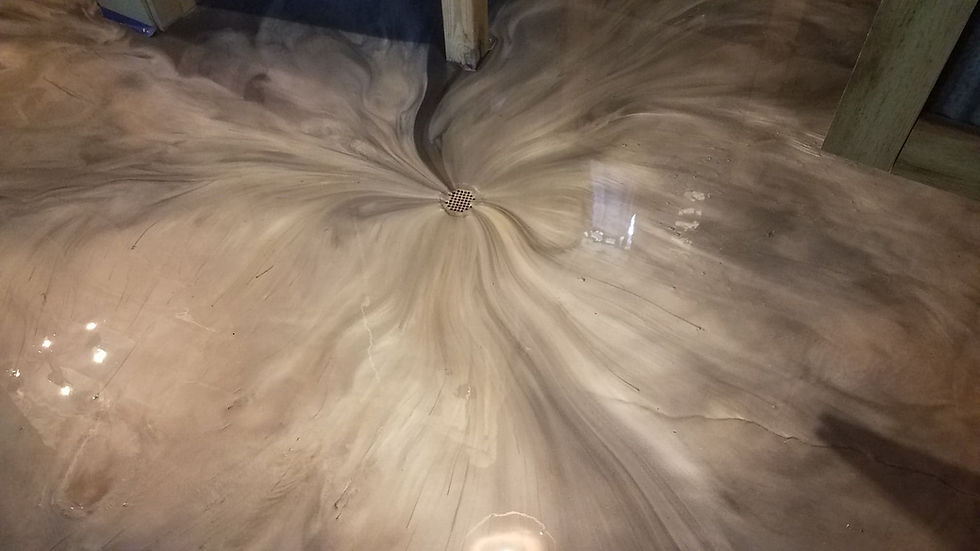Flooring Face-Off: Epoxy vs. Polyaspartic—Find Out Which One Is Best In Florida!
- lancebolam20347
- Sep 24, 2024
- 4 min read

As an expert in epoxy flooring at Paragon Epoxy Floors, I often get asked about the best flooring options for homeowners in Florida. With our unique climate, it’s essential to choose a flooring solution that withstands humidity and heat. Today, I want to discuss the differences between epoxy base coats and polyaspartic coatings, and why I firmly believe that epoxy is the superior choice, especially for Florida residents.
Understanding the Basics: Epoxy and Polyaspartic
What is Epoxy?
Epoxy is a durable, resin-based coating known for its strong adhesion and resistance to moisture. It forms a robust barrier on concrete surfaces, making it an excellent choice for garages, basements, and other areas prone to moisture. At Paragon Epoxy Floors, we use an epoxy product that includes a moisture barrier, which is crucial in our humid Florida climate.
What is Polyaspartic?
Polyaspartic is a relatively newer product that offers quick curing times and excellent UV resistance. It's particularly popular for outdoor applications because it doesn’t amber or fade when exposed to direct sunlight. However, while polyaspartic has its advantages, it lacks the moisture barrier that epoxy provides.
The Case for Epoxy
Moisture Resistance
One of the most significant benefits of using epoxy as a base coat is its moisture barrier when using the correct epoxy. Florida homeowners know that our wet season can bring daily rain, leading to potential moisture problems in your flooring. In my experience, when moisture seeps into the concrete, it can cause coatings to peel or fail—something you definitely want to avoid!
For instance, I recall a project we completed last July in a home that had just had polyaspartic applied as a base coat to the homeowners garage floor. The homeowners were thrilled with the initial appearance, but just a few months later, the coating began to peel due to the moisture buildup from daily thunderstorms. If they had opted for epoxy first, they would have had that added protection.
Durability and Longevity
Epoxy is renowned for its durability. When properly applied, it can withstand heavy foot traffic, chemical spills, and abrasions. This is especially important for garages and workshops, where tools and vehicles can cause significant wear and tear. At Paragon Epoxy Floors, we’ve seen epoxy last for years without signs of damage, making it a wise investment for homeowners.
Polyaspartic: The Sun Lover
Benefits of Polyaspartic
While I advocate for epoxy, I do recognize the benefits of polyaspartic, particularly when it comes to outdoor applications. Polyaspartic coatings cure quickly, allowing for rapid installations. They are also resistant to UV rays, making them an excellent choice for patios and driveways exposed to direct sunlight.
However, in Florida’s humid climate, using polyaspartic as a base coat can be risky. During the dry season, when rain is scarce, polyaspartic can perform adequately. But come July, when the afternoon storms roll in, the lack of a moisture barrier becomes a significant concern.
A Recommended Approach
For those who want the best of both worlds, I recommend a multiple coat system: start with an epoxy base coat for moisture protection, followed by a tinted polyaspartic layer, and finish with a clear polyaspartic topcoat or a urethane depending on where the coating is being applied. This combination offers the durability of epoxy with the UV resistance and aesthetic appeal of polyaspartic.
A Personal Experience
I once worked with a homeowner who initially wanted only polyaspartic for their porch because of cost. After discussing the humidity issues and the potential for moisture damage, we decided to use an epoxy base coat, followed by a tinted polyaspartic, then the flake, and then a polyaspartic topcoat. The homeowner was delighted with the results; not only did it look fantastic, but they also had peace of mind knowing their floor was protected against moisture. I happened to be helping my brother’s painting company and we stopped back at this homeowners house years later and the porch still looked amazing like the day I installed it.
Making the Right Choice for Your Home
Consider Your Environment
When choosing between epoxy and polyaspartic, consider your specific environment. In Florida, where humidity levels can soar and afternoon thunderstorms are common, the moisture barrier provided by epoxy is invaluable. However, if you have a covered outdoor space that receives plenty of sunlight, a multiple coat system utilizing polyaspartic is a much wiser option.
Consult with an Expert
Before making a decision, consult with flooring experts like those at Paragon Epoxy Floors. We can assess your space, understand your needs, and recommend the best coating system to ensure your floors look great and last for years.
Conclusion
In conclusion, while both epoxy and polyaspartic have their merits, I believe that epoxy provides the best foundation for flooring in Florida’s unique climate. With its moisture barrier, durability, and versatility, epoxy can protect your home against the challenges posed by humidity, heat, and hydrostatic pressure.
At Paragon Epoxy Floors, we’re dedicated to helping homeowners make informed decisions about their flooring options. Whether you’re looking to enhance your garage, patio, or driveway, we’re here to provide expert advice and top-quality installations. Remember, investing in the right flooring now will save you headaches and expenses down the road!







Comments